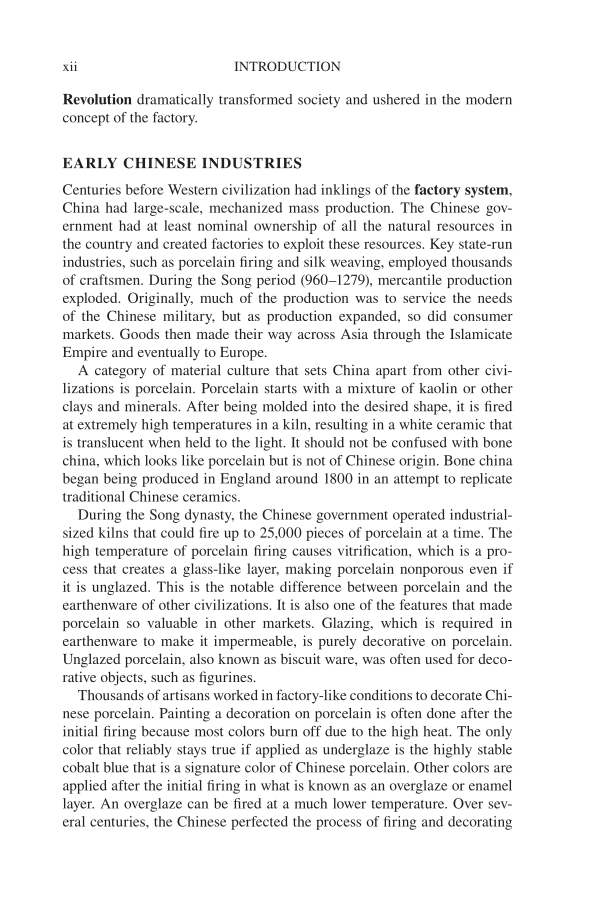xii INTRODUCTION Revolution dramatically transformed society and ushered in the modern concept of the factory. EARLY CHINESE INDUSTRIES Centuries before Western civilization had inklings of the factory system, China had large-scale, mechanized mass production. The Chinese gov- ernment had at least nominal ownership of all the natural resources in the country and created factories to exploit these resources. Key state-run industries, such as porcelain firing and silk weaving, employed thousands of craftsmen. During the Song period (960–1279), mercantile production exploded. Originally, much of the production was to service the needs of the Chinese military, but as production expanded, so did consumer markets. Goods then made their way across Asia through the Islamicate Empire and eventually to Europe. A category of material culture that sets China apart from other civi- lizations is porcelain. Porcelain starts with a mixture of kaolin or other clays and minerals. After being molded into the desired shape, it is fired at extremely high temperatures in a kiln, resulting in a white ceramic that is translucent when held to the light. It should not be confused with bone china, which looks like porcelain but is not of Chinese origin. Bone china began being produced in England around 1800 in an attempt to replicate traditional Chinese ceramics. During the Song dynasty, the Chinese government operated industrial- sized kilns that could fire up to 25,000 pieces of porcelain at a time. The high temperature of porcelain firing causes vitrification, which is a pro- cess that creates a glass-like layer, making porcelain nonporous even if it is unglazed. This is the notable difference between porcelain and the earthenware of other civilizations. It is also one of the features that made porcelain so valuable in other markets. Glazing, which is required in earthenware to make it impermeable, is purely decorative on porcelain. Unglazed porcelain, also known as biscuit ware, was often used for deco- rative objects, such as figurines. Thousands of artisans worked in factory-like conditions to decorate Chi- nese porcelain. Painting a decoration on porcelain is often done after the initial firing because most colors burn off due to the high heat. The only color that reliably stays true if applied as underglaze is the highly stable cobalt blue that is a signature color of Chinese porcelain. Other colors are applied after the initial firing in what is known as an overglaze or enamel layer. An overglaze can be fired at a much lower temperature. Over sev- eral centuries, the Chinese perfected the process of firing and decorating
Document Details My Account Print multiple pages
Print
You have printed 0 times in the last 24 hours.
Your print count will reset on at .
You may print 0 more time(s) before then.
You may print a maximum of 0 pages at a time.






































































































































































































